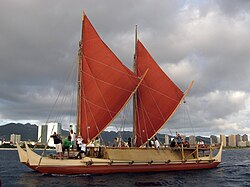 The Gaualofa | |
| History | |
|---|---|
| Samoa | |
| Name | Gaualofa |
| Owner | Samoa Voyaging Society |
| Builder | Salthouse Boatbuilders |
| Launched | 2009 |
| Identification |
|
| Status | Active |
| General characteristics | |
| Class & type | Vaka Moana |
| Tonnage | 13 tonnes [1] |
| Length | 72 ft (22 m) overall [1] |
| Beam | 21 ft (6.4 m) [1] |
| Draft | 6 ft (1.8 m) [1] |
| Propulsion | Sail / PV electric |
| Sail plan | crabclaw sails |
| Complement | 14-16 [1] |
Gaualofa is a reconstruction of a va'a-tele ("large canoe"), [2] a double-hulled Polynesian voyaging canoe. It was built in 2009 by the Okeanos Foundation for the Sea. [3] It was given to the Samoa Voyaging Society in 2012, on the occasion of Samoa's 50th anniversary of independence. [4] It is used to teach polynesian navigation.








